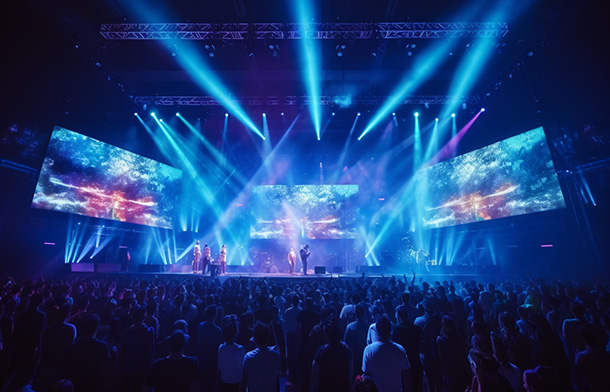 English
English
2025.05.07
In the digital age, the visual presentation and interactive experiences of large-scale events continue to push traditional boundaries. LED rental screens, leveraging their technological advantages and flexible features, have become a core medium for stage art and event planning. From concerts with tens of thousands of attendees to international conferences, commercial product launches, and cultural celebrations, LED rental screens are reshaping modern events through their unique value in both form and participatory engagement.
LED rental screens employ high-precision display technology and modular designs, delivering vivid, lifelike imagery while adapting to diverse spatial requirements through flexible configurations. Their high brightness and wide color gamut ensure stable visual performance under complex lighting conditions, providing clear and impactful visuals for both indoor immersive environments and outdoor long-distance viewing. This technological foundation empowers event organizers to transcend physical limitations in creative design.

Traditional two-dimensional stage setups are transformed into multidimensional spaces by LED rental screens. Elevating, rotating screen arrays combined with virtual reality technologies enable real-time interactions between stage backgrounds and performances. The seamless integration of performers and digital imagery creates fluid narrative scenes, immersing audiences in a blend of reality and illusion. This spatial reconfiguration turns every event into a unique artistic creation.
Modern LED rental screens have evolved from passive display tools into interactive platforms. Through motion capture and touch-responsive technologies, audience actions can directly trigger real-time changes in screen content. This participatory design breaks traditional spectator-performer boundaries, transforming audiences from passive viewers to active co-creators. Whether through motion-activated effects or collective visual interactions, such innovations amplify the memorability and engagement of events.
The detachable and reusable nature of rental screens significantly reduces resource consumption in event setups. Modular components allow rapid installation and cross-scenario reuse, minimizing material waste and shortening construction timelines. This lightweight operational model aligns with eco-friendly principles while reducing costs for organizers, driving the industry toward sustainable development.
Integration with IoT technologies has enabled intelligent upgrades for LED rental screens. Remote control systems adjust display parameters in real time to adapt to varying lighting conditions, while smart scheduling platforms precisely match equipment with venue demands. Through data-driven management, these screens evolve from visual carriers to intelligent hubs that synchronize lighting, audio, and special effects, ensuring seamless multi-system collaboration.
With advancements in flexible and transparent display technologies, LED rental screens will continue to expand their applications. Foldable screens will unlock innovative spatial designs, while deeper integration with augmented reality may create boundary-free interactive environments. As technological innovation resonates with artistic expression, LED rental screens are leading large-scale events toward a more imaginative future.
From visual storytelling to emotional resonance, and from technical support to ecosystem building, the value of LED rental screens transcends hardware. They are not merely information carriers but vital connectors between creativity, technology, and audiences. In the digital era, this fusion of practicality and artistry will continue to drive transformative energy into large-scale events, crafting spatial narratives for the digital age.